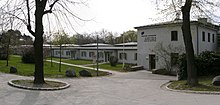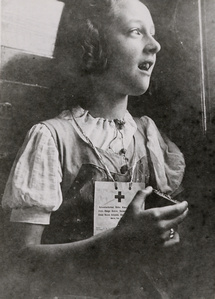Swiss donation
The Swiss donation to the war-damaged (also in the spelling and briefly as a Swiss donation common, french Don suisse pour les victimes de la guerre , Italian Dono svizzero per le vittime di guerra , Romansh Donaziun svizra ) in Europe 1944 bis 1948 was a public collection of the Swiss people as an expression of solidarity with the victims of the Second World War .
Collection campaign
The Federal Council's message of December 1, 1944, together with the brochure “Our people will thank” (1.5 million copies) gave the impetus for the largest Swiss collection campaign during the Second World War: “The Swiss donation to war victims should be ours Provide an opportunity for the population to witness the feelings of charity they feel. Every Swiss citizen, young or old, poor or rich, should be given the opportunity to take part in a work through which he or she fulfills a moral obligation towards his severely tested neighbor. [...] This charitable mission corresponds to one of the most honorable traditions in Switzerland. We are not breaking new ground with this. But because the misery to be alleviated is widespread and goes deeper than ever before, our willingness to help must also call for a corresponding effort. "
In December 1944, the federal government made available over 150 million francs, while the public collection from February 1945 to March 1946 brought in a further 50 million, which corresponds to around 1 billion Swiss francs according to today's (2005) value.

Aid organizations
From 1944 onwards, the Swiss donation was used to finance humanitarian aid activities in eighteen European countries including Germany. The Federal Council set up a national committee under the presidium of former Federal Councilor Ernst Wetter with representatives from all social classes, which determined the most important guidelines of the aid organization. Rodolfo Olgiati (1905-1986), a mathematics teacher from Bern, which is already the Swiss Group for Spain Children (SAS) was founded in 1940 central secretary of the Swiss Association for war-affected children (SAK) and from 1942 the Children's Aid of the Swiss Red Cross had been In 1943 appointed head of the central office for Swiss donations.
The actual implementation of the campaigns abroad was primarily entrusted to the Swiss Red Cross and the Children's Aid of the Swiss Red Cross , the Swiss Workers' Relief Organization , the Swiss Caritas Association and the Aid Organization of the Evangelical Churches in Switzerland . The “country offices” of the Swiss donation coordinated the aid in the individual countries. There was also the “Department for Hospitalization”, “Offices for Training”, “Agricultural Offices”, “Office for Assistants”, “Sponsorship Service” and, as the most important specialist office, the “Sanitary Service”. A specially set up “travel agency” organized the aid workers' trips to war-torn Europe and obtained around 5200 visas for employees of the Swiss donation and 1200 for employees of other aid organizations.
helper
Well-known artists, photographers and volunteers from many professional groups are selflessly committed to the aid projects, as the following examples show:
- Regina Kägi-Fuchsmann (1889–1972), managing director of the Swiss Workers' Relief Organization (SAH), played a key role in organizing the Swiss donation. In 1948 she became president of the successor organization to Swiss donations, Schweizer Europahilfe (Swiss international aid).
- August R. Lindt (1905–2000), delegate of the ICRC in destroyed Berlin, helped organize the Swiss donation. From 1956 to 1960 he was the United Nations High Commissioner for Refugees
- Gertrud Lutz-Fankhauser (1911–1995) - Carl Lutz's wife and later UNICEF Vice-President - traveled to Bosnia in January 1946 for the Swiss donation with a medical mission . In the post-war winter of 1946/1947 she headed a “Swiss Donation” mission in Finland and then in Poland (1947–1948).
- Elisabeth Rotten (1882–1964), reform pedagogue, as head of the Swiss donation office for cultural exchange , organized a trip to Switzerland for German educators in autumn 1948 with the aim of getting them out of their isolation and reintegrating them internationally.
- Margherita Zoebeli (1912–1996), reform pedagogue, built up the internationally recognized Centro educativo italo-svizzero CEIS in Rimini in addition to numerous aid campaigns with the Swiss workers' relief organization , was its director from 1946 to 1971 and remained associated with him throughout her life.
Assistance

The most urgent aid was given to the fight against hunger, the cold and homelessness and the fight against disease. The aid projects overseen by Swiss experts ranged from the household to school and hospital facilities. In cooperation with UNESCO , the Swiss donation helped to rebuild schools and libraries and to organize courses and with grants.
The principle of non-partisanship in the spirit of Henry Dunant applied to the relief work . Neither religious nor political attitudes, but only the extent of the need should play a role. The principle of non-partisan aid was part of the Swiss character of the Swiss donation. It was based on the entire Swiss people and was not the sole work of a denominational or ideological group.
Informing the population
The Swiss painter and draftsman Charles Hug (1899–1979) designed posters for the “Swiss donation” as an army reporter. Immediately after the end of the war, Paul Senn took photos in Germany and France on behalf of the Swiss donation. The photo reporter Theo Frey traveled in 1945 on behalf of the Swiss Red Cross to the war-torn areas in Lorraine and Normandy for the Swiss donation . In 1947 Paul Senn traveled to Finland with other Swiss reporters at the invitation of the Swiss donation. In Germany he documented the reconstruction.
The Swiss monthly " Du " from May 1946 contains impressive texts and photos by Werner Bischof about the Swiss donation. Arnold Kübler wrote about the misery of hundreds of thousands of children who had lost their father, mother and siblings in Europe during World War II and showed that the activities of the aid organizations and Swiss donations were vital for countless people. In 1949 a comprehensive final report with exemplary photo documentation was created by the Swiss photographers Werner Bischof (1916–1954), Paul Senn, Ernst Scheidegger and the graphic artist Adolf Flückiger . The report documents and describes all assistance and the use of the funds.
Examples of help
School meals for the city of Vienna and the surrounding area
In September 1945, the first shipments of food arrived for student meals one of 127,000 children as well as medicines and medical supplies. To counteract infant mortality, milk was distributed to the young children. In 1946, all school children in the City of Vienna received a bar of chocolate at the start of school and at Christmas, 319,000 children in Vienna, Lower Austria and Burgenland. There were also blankets, diapers, wool and darning thread for mending, men's, women's and children's shoes, sewing machines, household items, furnishings and equipment for shoemaker's and tailor's workshops, and devices for operating large kitchens. “Schweizer Spende” organized 135 stays in Davos and Arosa for Viennese people suffering from tuberculosis. By the end of 1946 the following deliveries of the "Swiss donation" took place to Vienna, Lower Austria and Burgenland:
- 8,687 tons of food, medicines, medical supplies, medical supplies worth 1.2 million Swiss francs
- 33,315 kg and 24,559 pieces of textiles
- 24,812 pairs of shoes
Children's trains from Hamburg to Switzerland
In two days and two nights, children aged four to ten from Hamburg took the train to Switzerland, organized by the Swiss Red Cross. They were invited to “pep up” for three months by friendly Swiss host families in the spirit of Christian charity and accepted into the family. From this, lifelong feelings of gratitude and solidarity developed among the war children. In total, the Swiss population personally helped 44,000 war children from Germany.
Swiss aid on Lake Constance
- Friedrichshafen : Swiss children were the names of the thousands of children who were invited by "generous" Swiss people who, for example, entered Switzerland via Friedrichshafen .
- Constance : School meals with pea, oat or barley soup were organized for three months from the spring of 1946 by the Kreuzlingen factory owner Carl Schuler and Frida Siegrist from Constance. In 1946, students from Konstanz were invited by Thurgau families to eat and dress up several times a week at Kreuzlinger Zoll .
See also
literature
- E. Wetter and Rodolfo Olgiati: Activity report Die Schweizer Spende 1944–1948 , Dr. E. Wetter and Rodolfo Olgiati, 1949
- Markus Schmitz and Bernd Haunfelder : Humanity and Diplomacy. Switzerland in Cologne 1940–1949 . Aschendorff, Münster 2001, ISBN 3-402-05385-3 .
- Working group of the association "Swiss Children": The miracle of a journey. The "Swiss Children" and their trip to fairy tale land . Robert Gessler, Friedrichshafen 2003, ISBN 3-86136080-2 .
- Markus Schmitz: West Germany and Switzerland after the war. The reorganization of bilateral relations 1945–1952 . Verlag Neue Zürcher Zeitung, Zurich 2003, ISBN 3-03823037-5 .
- Bernd Haunfelder : Children's trains to Switzerland. The Germany Aid of the Swiss Red Cross 1946–1956 . Aschendorff, Münster 2007, ISBN 3-402-12730-X .
- Bernd Haunfelder, need and hope. German children and Switzerland 1946–1956 . Aschendorff, Münster 2008. ISBN 978-3-402-12776-6 .
- Bernd Haunfelder (Ed.): Swiss help for Germany. Appeals, reports, letters, reminders, speeches, 1917-1933 and 1944-1957 . Aschendorff, Münster 2010, 244 pages, ISBN 978-3-402-12870-1 .
- Madeleine Lerf: "Buchenwald children " - a Swiss aid campaign . Publications of the Archives for Contemporary History of the ETH Zurich (Volume 5). ETH Zurich, Zurich 2009, ISBN 978-3-0340-0987-4 .
- Christian Koller : 70 years ago: The end of the Second World War in Europe and Switzerland , in: Sozialarchiv Info 2 (2015). Pp. 3-11.
Web links
- Peter Hug: Swiss donation to the war victims. In: Historical Lexicon of Switzerland .
- Holdings: Olgiati, Rodolfo (1905–1986) in the finding aids of the Swiss Social Archives
- The Swiss donation for Vienna
- The children's aid of the Swiss Red Cross
- Recreation for children in Switzerland
- Zurich helps Vienna
- Centrale Sanitaire Suisse
- Swiss sponsorship
- Swiss Mission Caritas
- Aid organization of the Protestant churches in Switzerland
- Swiss Quaker Aid
- Website of the association "Swiss Children" 1946/47
- Special kindergarten Swiss donation Vienna, built in 1949
- Swiss donation in Alsace ( Memento from May 26, 2013 in the Internet Archive )
- Swiss workers' welfare organization as campaigner for the Swiss donation in Cologne
- The Swiss donation in Kleve
- Swiss donation for the ruined children in Gelsenkirchen
- Swiss donation in the archive database of the Swiss Federal Archives
Individual evidence
- ↑ cf. Confederation. Archive https://www.eda.admin.ch/content/dam/parl-vor/2nd-world-war/1945-1949/schweizer-spende-spuehler.pdf
- ↑ Tagblatt der Stadt Zürich from April 28, 2015: "A gate opens, fetters fall"
- ↑ Swiss Social Archives: Food distribution by employees of Schweizer Spende, Cologne 1946
- ↑ Swiss Social Archives: Swiss donation vehicle in Poland in 1948
- ↑ Vanessa Seifert: "From Hell to Paradise" - a Hamburger in the children's train from 1946. In: Hamburger Abendblatt of December 17, 2009, p. 20
- ↑ Sandra Pfanner: The neighbors helped to survive. In: Südkurier of March 24, 2015.




